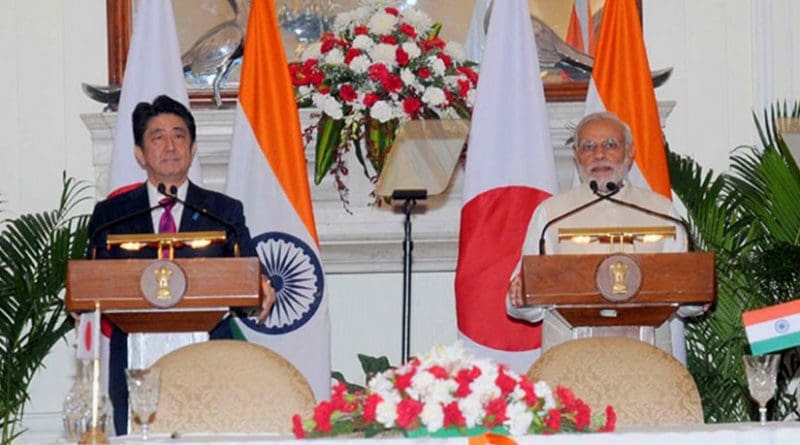Challenges Before Abe In Operationalising Nuclear Agreement – Analysis
By Observer Research Foundation
By K. V. Kesavan*
When Japanese Prime Minister Shinzo Abe’s visit to India for attending the 9th summit was announced, even many informed observers had scepticism about its outcome. They believed that the single most important issue that would decide the success or otherwise of his visit would be the civil nuclear cooperation. This issue had been hanging in balance for over five years and people became weary of being told repeatedly that both governments would “accelerate negotiations for a speedy agreement”.
Even this time, very few people really expected a positive outcome. Until a day before the Modi-Abe meeting on 12 December, official spokesmen were waxing eloquent on the prospects of an agreement on the Ahmedabad-Mumbai high speed rail project which many thought was whipped up to take the focus away from the nuclear issue. But behind the scene serious and hectic negotiations were taking place to hammer out a device to end the prolonged stalemate. That is how the present formula has emerged, as a “partial settlement” to the issue, as some would call it.
The Modi-Abe joint statement says that they welcome the memorandum of understanding between the two governments on the Agreement for Cooperation for Peaceful Uses of Nuclear Energy which will be signed after the technical details including internal procedures are finalized. Prime Minister Modi called this accord as “more than just an agreement for commerce and clean energy”. He said, “It is a shining symbol of a new level of mutual confidence and strategic partnership in the cause of peaceful and secure world.” While recognizing the significance of the accord for Japan, Modi assured that India would respect and honour its commitments.
While this decision has paved the way for negotiating the details of the agreement, the focus has now shifted to what Mr Abe will do to push the agreement through from now on. He has to navigate it skillfully amidst a great deal of domestic imponderables. Influential anti-nuclear elements will whip up resistance to the agreement as they have been doing for years. To be sure, the mayors of Hiroshima and Nagasaki have already voiced their opposition. In addition, many commentators have expressed their criticisms in media columns. The Asahi Shimbun has already taken the lead in stating that Japan would be making a major shift in its nuclear policy by providing nuclear technology to a country which is not a party to the NPT. It commented, “Providing nuclear technology to such a nation should be called an act of folly that makes light of the longstanding and persevering nuclear nonproliferation efforts of the global community and would further emasculate the nonproliferation regime.”
While steering the agreement, Abe will have to cross a few hurdles. First, in the Japanese system, the agreement will have to be approved by the Diet. Though Abe has more than comfortable parliamentary strength, he may still face the criticism of a strong anti-nuclear lobby often cutting across party lines. Second, his own coalition partner, the Komeito has strong views on the nuclear issues and Abe would be advised by his own party colleagues to carry the Komeito along as he is going to face a crucial upper house election in July next year. Many commentators also fear that a host of other political issues concerning consumption tax , the progress of Abenomoics, etc, may also arise in the coming months that could blur the Japanese political scene. From the perspective of the ruling Liberal Democratic Party, how Abe is going to mould a consensus on this issue would be of paramount importance.
But there are also compelling reasons for Abe to push the MOU to its logical conclusion. Apart from the Chinese factor which many believe has been one chief driving reason, Abe sees that Japan alone cannot dictate terms in the technological sphere. Unless Japan signs this agreement, Westinghouse and the General Electric cannot use Japanese technology to set up nuclear reactors in India. There are reports that China has acquired several critical technologies from Western companies and is in a position to offer its knowhow to India and other countries. Even South Korea has been working hard to find a footing in India’s nuclear field. These are some of the compulsions that Abe faces while addressing this issue.
Apart from the nuclear issue, there are important takeaways from the summit meeting like Japan’s participation in the construction of the high speed bullet rail system between Mumbai and Ahmedabad costing about $12 billion. In addition, Japan has been assigned a huge role in the modernization of Indian railways. No less important is the flow of Japanese ODA loans to India in fiscal year 2015 which has reached an unprecedented figure of about Y400 billion.
In addition, Japan has allotted upto 1.5 trillion yen for make-in India programme which aims to promote direct investment of Japanese companies and trade from Japan to India and to support their business activities with counterparts in India including development of infrastructure.
To strengthen their strategic relations further, both countries have also signed agreements on (a) the transfer of defence equipment and technology and (b) security measures of the protection of classified military information. These will go a long way in deepening their bilateral defence cooperation. In this context, they have also expressed their desire to undertake projects such as US-2 amphibian aircraft to deepen their defence cooperation.
*Prof K.V. Kesavan, currently based in Tokyo, is a Distinguished Fellow at Observer Research Foundation, Delhi

